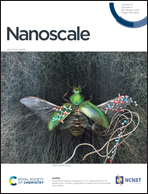Nanoparticles decorated with granulocyte-colony stimulating factor for targeting myeloid cells†
Abstract
Dysregulated myeloid cell activity underlies a variety of pathologies, including immunosuppression in malignant cancers. Current treatments to alter myeloid cell behavior also alter other immune cell subpopulations and nonimmune cell types with deleterious side effects. Therefore, improved selectivity of myeloid treatment is an urgent need. To meet this need, we demonstrate a novel, targeted nanoparticle system that achieves superior myeloid selectivity both in vitro and in vivo. This system comprises: (1) granulocyte-colony stimulating factor (G-CSF) as a targeting ligand to promote accumulation in myeloid cells, including immunosuppressive myeloid-derived suppressor cells (MDSCs); (2) albumin nanoparticles 100–120 nm in diameter that maintain morphology and drug payload in simulated physiological conditions; and (3) a fluorophore that enables nanoparticle tracking and models a therapeutic molecule. Here, we show that this strategy achieves high myeloid uptake in mixed primary immune cells and that nanoparticles successfully infiltrate the 4T1 triple-negative breast tumor murine microenvironment, where they preferentially accumulate in myeloid cells in a mouse model. Further development will realize diagnostic myeloid cell tracking applications and therapeutic delivery of myeloid-reprogramming drugs.



 Please wait while we load your content...
Please wait while we load your content...